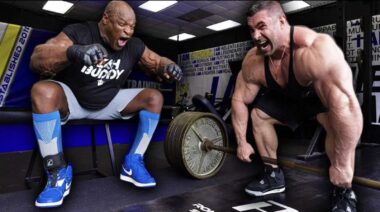I hate training arms. Especially biceps. It isn’t that I have inferior strength or development, it’s just because it’s boring. Think about it; what traditional exercises do you perform for biceps? I can think of only one straight out of the bro-cyclopedia: curls. All you do for biceps is curl. Barbell curl, dumbbell curl, incline bench curl, preacher bench curl, concentration curl, cable curl, hammer curl, reverse curl, seated curl, and the list can go on and on.
Triceps aren’t much more exciting. Traditionally for triceps, you extend the arm—that’s it. Whether it’s standing, seated, or lying down, all you do is extend with a barbell, dumbbell, or cable apparatus.
Tired. Boring. Been there, done that. Sound familiar? Then you might want what I’ve been having lately: a great big dose of the unconventional.
Get Out of Your Isolation Rut
Be honest. How are all those curls and extensions working for you? Have those moves fulfilled all of your hopes and dreams of bigger, stronger arms?
Wipe your arm training slate clean and let’s adopt a different mindset. Instead of thinking of arm training as a series of isolated movements, think more whole-body. Visualize your arms as part of a bigger picture of functionality and mechanics, and how different angles, big body movements, and residual stimulation can affect their development.
The first order of business is to take a look at the larger muscle groups. All chest press exercises will also stimulate your triceps, and all back-pull motions will work your biceps as well. You need to perform these big moves in order to have a chance at packing on any serious arm size. Have you ever seen a pair of giant triceps on someone who also didn’t bench press a lot of weight, or someone with huge biceps who couldn’t do pull-ups or row a ton? I didn’t think so.
Serve yourself a heaping helping of heavy presses, pull-ups, and rows. Now, this isn’t a green light to go crazy and swing, heave, and cheat up a bunch of weight and end up hurting yourself. Always practice textbook form, and try your best to feel each exercise in the intended area. The point is to include those key exercises and focus on being progressive in each one. The byproduct will be a load placed on your arms that no curl or press down could achieve.
Frequency Check
The other flaw in traditional hypertrophy programs is that most of them call for an arm day once per week. Normally, these days are filled with countless sets and reps of (painfully boring) isolation work. That may work for a few, but if you’re struggling with progression, a little more frequency is in order.
Splitting up your current weekly volume into two separate arm sessions per week will effectively increase frequency, while your volume remains the same. In other words, you’ll double up your stimulation and growth potential, but still train with the same amount of sets. That’s instant weekly progression. Additionally, you’ll keep overtraining in check by avoiding annihilating your arms, pummeling them into the ground without any hope for recovery. Volume, load, and intensity will be just right for increased frequency, strength progression, and adequate recovery.
Unconventional Arm Training
With this whole-body mindset in place, let’s ditch the ultra-isolation work for a while and instead focus on some bigger, more functional moves that will give your arms a new stimulus and a better reason to grow bigger and stronger.
The great thing about this switch is that you’ll perform most of the exercises with little to no equipment. All you’ll need is a fixed low bar, a pull up bar, bands, and a bench. No dumbbells, barbells, or specialized machines required. With moves like close-grip push ups, biceps chin ups, and rack bar nose breakers among many others, you’ll also get the residual effect of training the surrounding muscle groups for better overall development. For example, triceps dips also hit the chest, and any chin up designed for biceps will also work your back to an extent.
Here’s the short list of the unconventional arm exercises that are included in the workouts below:
- Parallel bar dips
- (Feet elevated) close-grip push ups
- Suspension trainer (TRX) triceps presses
- Curl-grip chin ups
- Curls with bands
- Inverted bar curls
- Suspension trainer (TRX) biceps curls
Here’s the part of the article that most bros will skip. When performing bodyweight exercises, many lifters will haphazardly perform sloppy reps just to get more (they think) out of each set. The fact is, textbook form is just as important as ever when using your bodyweight. If you want to target specific muscle groups and take advantage of the residual effect, then your form must be impeccable in order for all of the supportive muscle around the targeted area to be engaged. Keeping solid form will also help stabilize your joints and core, and prevent potential injury.
Below is a sample training routine with all of the factors above included. As stated earlier, you won’t need much by way of equipment, just a few key items and your willingness to try something different for a change.
Try this routine for 4-6 weeks while temporarily ditching what you’re currently doing for arms. Do session 1 and session 2 once per week each, either on a designated day, or tacked onto another major muscle group.
Exercises labeled 1A and 1B are to be performed back-to-back with little to no rest between. Same thing goes for 2A and 2B. After each pair is performed, take a one minute rest. Shoot for as many reps as possible for each exercise.
Session 1
- 1A: Suspension trainer biceps curls
- 1B: Suspension trainer triceps extensions
- 2A: Floor close-grip push ups
- 2B: Curls with bands
Session 2
- 1A: Parallel bar dips
- 1B: Curl grip chin ups
- 2A: Feet-elevated close-grip push ups
- 2B: Inverted bar curls to forehead






